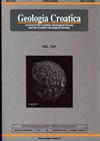Comprehensive characterization of bentonites from Croatia and neighboring countries
IF 1.1
4区 地球科学
Q3 GEOLOGY
引用次数: 2
Abstract
Bentonites are an important industrial resource and are also interesting from the mineralogical point of view. The main component of bentonites is a mineral from the smectite group in which chemical and structural variations, influencing bentonite properties, provide a great deal of interesting research topics. The aim of this study was to better describe bentonites from 11 known deposits from Croatia and neighbouring countries: Bednja, Bunaric, Draga, Divoselo, Sjenicak, Paripovac, Loncarski Vis and Poljanska Luka (Croatia), Zaloska Gorica (Slovenia), Sipovo (Bosnia and Herzegovina) and Vranjska Banja (Serbia). Thirteen samples were analysed using several available techniques in order to obtain the data necessary for currently accepted bentonite classification. The mineralogical composition was analysed using XRD and FTIR, and crystallo-chemical properties were investigated by thermal analysis, CEC determination with ammonium index cations, chemical analyses (ICP-AES and ICP-MS) and Mossbauer spectroscopy. The results showed that the main mineral constituent of most local bentonite deposits is a Fe-poor smectite, with a predominantly medium layer charge mostly as a result of octahedral substitutions, with calcium or sodium cations occupying the interlayer. Nevertheless, the variations between samples are prominent enough to provide a good overview of the range of crystallo-chemical properties which exist in different smectites resulting in varying bentonite properties.克罗地亚及周边国家膨润土的综合表征
膨润土是一种重要的工业资源,从矿物学的角度来看也很有趣。膨润土的主要成分是蒙脱石组分中的一种矿物,其化学和结构变化对膨润土性能的影响提供了许多有趣的研究课题。本研究的目的是更好地描述克罗地亚及其邻国11个已知矿床的膨润土:Bednja、Bunaric、Draga、Divoselo、Sjenicak、Paripovac、Loncarski Vis和Poljanska Luka(克罗地亚)、Zaloska Gorica(斯洛文尼亚)、Sipovo(波斯尼亚和黑塞哥维那)和Vranjska Banja(塞尔维亚)。使用几种可用技术对13个样品进行了分析,以获得目前公认的膨润土分类所需的数据。用XRD和FTIR分析了矿物成分,并通过热分析、铵指数阳离子CEC测定、化学分析(ICP-AES和ICP-MS)和穆斯堡尔谱研究了晶体化学性质。结果表明,大多数局部膨润土矿床的主要矿物成分是贫铁蒙脱石,其主要中间层电荷主要是由于八面体取代,钙或钠阳离子占据了中间层。然而,样品之间的差异足够显著,可以很好地概述不同蒙脱石中存在的晶体化学性质的范围,从而导致膨润土性质的变化。
本文章由计算机程序翻译,如有差异,请以英文原文为准。
求助全文
约1分钟内获得全文
求助全文
来源期刊

Geologia Croatica
GEOSCIENCES, MULTIDISCIPLINARY-
CiteScore
2.90
自引率
23.10%
发文量
35
审稿时长
>12 weeks
期刊介绍:
Geologia Croatica welcomes original scientific papers dealing with diverse aspects of geology and geological engineering, the history of the Earth, and the physical changes that the Earth has undergone or it is undergoing. The Journal covers a wide spectrum of geology disciplines (palaeontology, stratigraphy, mineralogy, sedimentology, petrology, geochemistry, structural geology, karstology, hydrogeology and engineering geology) including pedogenesis, petroleum geology and environmental geology.
Papers especially concerning the Pannonian Basin, Dinarides, the Adriatic/Mediterranean region, as well as notes and reviews interesting to a wider audience (e.g. review papers, book reviews, and notes) are welcome.
 求助内容:
求助内容: 应助结果提醒方式:
应助结果提醒方式:


